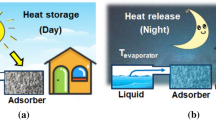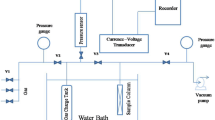Multilayer carbon nanotubes obtained by pyrolytic treatment and mechanical activation of amorphous carbon, synthesized from various plant materials, are distinguished by high hydrogen sorption capacity. We have studied the microstructure of the amorphous carbon and the nanotubes. We have found that the mechanical activation time and hydrogen saturation conditions affect the sorption capacity of the nanotubes.


Similar content being viewed by others
References
S. Iijima, Nature, 354, 56–58 (1991).
W. Pan, X. Zhang, S. Li et al., Int. J. Hydrogen Energy, 30, 719–722 (2005).
P. S. Fernandez, E. B. Castro, S. G. Real et al., Int. J. Hydrogen Energy, 34, 8115–8126 (2009).
B. P. Tarasov, N. F. Gol’dshleger, and A. P. Moravskii, Usp. Khim., 70, No. 2, 150–166 (2001).
Y. Ye, C. C. Ahn, C. Witham et al., Appl. Phys. Lett., 74, No. 16, 2307–2309 (1999).
Yu. I. Tyurin, V. V. Larionov, and N. N. Nikitenkov, Russian Journal of Physical Chemistry A, 85, No. 6, 1047–1053 (2011).
L. Zhou, Y. Zhou, and Y. Sun, Int. J. Hydrogen Energy, 31, 259–264 (2006).
A. C. Dillon, K. M. Jones, T. A. Bekkedahl et al., Nature, 386, No. 27, 377–379 (1997).
Y. Ye, C. C. Ahn, C. Witham et al., Appl. Phys. Lett., 74, No. 16, 2307–2309 (1999).
D. V. Onishchenko, V. P. Reva, V. G. Kuryavyi et al., Koks i Khimiya, No. 9, 35–39 (2012).
D. V. Onishchenko and V. P. Reva, Koks i Khimiya, No. 10, 38–41 (2012).
D. V. Onishchenko, V. P. Reva, and V. G. Kuryavyi, Koks i Khimiya, No. 12, 35–38 (2012).
D. V. Onishchenko, V. P. Reva, V. V. Chakov et al., Doklady Akademii Nauk, 447, No. 4, 418–420 (2012).
D. V. Onishchenko, V. P. Reva, and V. G. Kuryavyi, Koks i Khimiya, No. 2, 33–36 (2013).
D. V. Onishchenko and V. P. Reva, Khim. Tekh. Topliv Masel, No. 2, 3–6 (2013).
Author information
Authors and Affiliations
Additional information
Translated from Khimiya i Tekhnologiya Topliv i Masel, No. 4, pp. 3 – 6, July – August, 2013.
Rights and permissions
About this article
Cite this article
Onishchenko, D.V., Reva, V.P. Use of multilayer carbon nanotubes made from plant materials as sorption-based hydrogen storage containers. Chem Technol Fuels Oils 49, 281–286 (2013). https://doi.org/10.1007/s10553-013-0442-8
Published:
Issue Date:
DOI: https://doi.org/10.1007/s10553-013-0442-8




